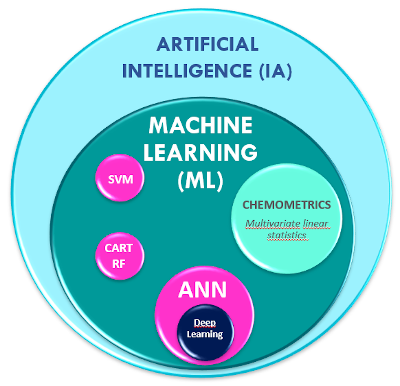What are Chemometrics? What is Machine Learning?
What are the differences and similarities between Chemometrics and Machine Learning?
From our point of view, the definition of Chemometrics is a set of mathematical tools and statistical methods allowing us to analyze multivariate data, instrumental or not, and mainly to answer linear problems.
The definition of Machine Learning could be summarized as a set of advanced mathematical and statistical methods for the analysis of data presenting more complex issues, and in particular thanks to non-linear methods.
As such, Chemometrics can be seen as a subset of the Machine Learning domain, which is itself included in the Artificial Intelligence domain.

Chemometrics
Chemometrics is a discipline that uses mathematical and statistical methods to optimally analyze data. It includes the fields of mathematical modeling (analysis of multivariate data) and experimental designs.
The historical development of Chemometrics over the past twenty years has gone hand in hand with the development of numerous sensors, in particular near infrared spectroscopy, and obtaining masses of data (spectroscopic, physico-chemical, sensory, etc..).
Linear data analysis methods (Principal Component Analysis -PCA-, multivariate PLS-type regression, etc.) have always been at the heart of Chemometrics.
Chemometrics encompasses two types of multivariate data analysis methods:
- so-called exploratory, or unsupervised or “data mining” methods, which make it possible to identify trends or clustering in data in an unsupervised manner, that is to say only on data from input, for example optical measurements;
- supervised methods, i.e. in which the models are based on the input and output data (for example, the vibrational spectra and the chemical composition of the sample to be predicted); these chemometrics methods can be either quantitative predictions (example: prediction of chemical concentrations) or qualitative predictions (example: discrimination of product categories).
The aim of these identification methods is to differentiate classes according to instrumental measurements made on samples. Various methods exist, the most used of which are SIMCA (Soft Independent Modeling Class Analogy) or PLS-DA (Partial Least Square Discriminant Analysis).
Machine Learning
In recent years, with the arrival of massive databases (Big Data, IoT connected objects – Internet of Things), many Machine Learning methods have appeared.
Machine Learning has been developed in many areas of application, to solve a practical task, such as for the recognition of objects (Pattern Recognition) in imagery or in texts (faces, diagrams, natural languages, writing, syntactic forms, etc.), to help in diagnostics in various fields (medical, financial analysis, pharmaceutical industry, petrochemical, food industry, etc.).
Thus, Machine Learning can be applied to different types of data, such as graphs, trees, curves, or more simply continuous or discrete data, but also instrumental data, in particular that resulting from vibrational spectroscopy (visible spectroscopy- near infrared, infrared, Raman, etc.). Generally, these databases are made up of many observations (called objects, examples or samples), so huge that in some cases we speak of “Big Data”, and of a large number of observed variables, but generally smaller than the number of observations.
Among supervised methods resulting from Machine Learning, we find in particular: Support Vector Machines – SVM – methods, decision tree methods (CART, Random Forests, boosting methods) or Artificial Neural Networks, ANN -, now called “Shallow networks” as opposed to “Deep networks” in Deep Learning field.
They talk about us
« Ondalys, pour valider notre façon de travailler »
Our expertise for the analysis of your data
With more than 15 years of experience in Chemometrics and Machine Learning, in particular applied to spectroscopic measurements, analytical data, process parameters and sensory descriptors, the experts of our teams accompany you at each stage of your projects.
Need a tailor-made training?
Our teams study your request in detail to offer you personalized training.
